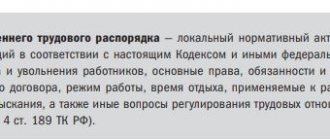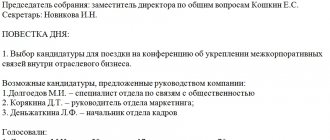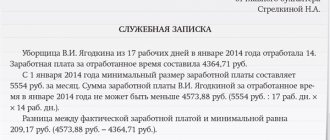What is “Internal Labor Regulations”
Internal labor regulations are usually understood as standards for the organization of labor, working hours, relationships within the team, the procedure for rewarding and punishing employees, the use of official uniforms and work clothes, and other points important for the normal functioning of the enterprise.
Each company has the right to develop internal labor regulations individually and arbitrarily, based on its own understanding of the document, but with an eye to the Civil and Labor Code of the Russian Federation. Internal regulations are a local document of the company, which has application and significance only in this particular enterprise.
Despite the fact that the Rules are not mandatory, they occur quite often, which is understandable. This document helps to establish discipline in the organization, is important for increasing labor productivity, increasing the quantity and quality of products and, in general, in a more global sense, it contributes to the development of the enterprise and the expansion of prospects.
Each person, when applying for a job in a company that applies the Internal Labor Regulations, must be familiarized with them against signature.
This equally applies to those who work part-time, are on a business trip, or are undergoing training at an organization.
Making changes to the PVTR: procedure
| Stages of making changes to the PVTR | What is included |
| Formation of a special working group | This group, as a rule, includes specialists from the human resources department, accountants, lawyers, as well as other structural divisions of the company, if necessary. One of the members of such a group is appointed responsible for drafting the changes. |
| Coordination of the draft changes with the working group | After the group members discuss the draft changes, they put their signatures on it |
| Coordination of the draft changes with the trade union | The trade union reviews the draft changes and sends its opinion to the manager in writing, within 5 working days from the date of receipt of the draft changes. |
| Determining how to make changes to the Rules | The method of introducing changes to the Rules will depend on how this document is currently drawn up: as an annex to the collective agreement, or as a separate document. |
| Informing employees about the changes | For familiarization, use a familiarization sheet or a log of familiarization with local regulations. |
| ★ Best-selling book “Accounting from scratch” for dummies (understand how to do accounting in 72 hours) > 8,000 books purchased |
When are the Rules adopted and why should they be changed?
The document is usually formed at the very beginning of the company's activities. It is prepared by the management of the organization together with the legal service and issues an order approving the internal labor regulations. However, in the process of development of an enterprise, working conditions may arise that are not regulated by the Rules; in addition, some important changes may occur in the Legislation. It is in such cases that it is necessary to edit the current document.
All company employees must also be familiarized with the amendments that have appeared in the Rules in the prescribed manner.
Example of PVTR (internal labor regulations) with all changes to the Labor Code of the Russian Federation in 2020
1 0 5374
Any company, be it manufacturing or selling, must work as a well-coordinated mechanism. This requires the approval and implementation of certain rules. Let's talk about how work should be organized in accordance with the law, and what the manager needs to remember.
What it is
PVTR - internal labor regulations. These are the basics that are written down in the internal regulatory act of the organization, requiring unconditional implementation. It depends on them how the enterprise will operate, what the work schedule of employees is and the procedure for taking vacations.
These rules must not contradict or run counter to the law. In the event of an inspection, inspectors ask to see the document and carefully study it.
There are two types of rules:
- independent document;
- annex to the collective agreement.
It is important to understand that this document is drawn up primarily for the organization’s employees, so it should be available to them during working hours.
Let's figure out what should be included in the rules.
They regulate a number of complex issues:
- hiring and dismissal of employees;
- liability of employees and employer;
- hours of work and time for rest;
- rewards, punishments;
- rights of the parties.
These parameters may differ in different organizations depending on the specifics of its activities.
For example, some enterprises must work in shifts and around the clock, while for others 8-10 hours a day is enough to function. Accordingly, the daily routine, rest, responsibility, and so on are different.
Legislation
According to Article 189 of the Labor Code of the Russian Federation, internal rules are regulated, drawing up a local act is mandatory, which is also specified in the law.
If the manager believes that the number of employees influences the need to compile PVTR, then he is mistaken. Even with a minimum of hired employees, the act must be approved.
After it has been compiled and approved by the manager, all employees, including those hired, are familiarized with it.
The provisions of the PVTR can be developed not for one year, but for years to come. The law does not prohibit this.
Article 190 of the Labor Code of the Russian Federation states that when drawing up a local act, the employer must take into account the opinion of the trade union organization. How exactly this opinion is taken into account is described in detail in Article 372 of the same legislative act.
The main provisions are:
- the draft local act with the rules is sent for consideration to the trade union before signing;
- after 1-5 working days, the trade union must give a written response, indicating its reasoned opinion;
- within 3 days after becoming familiar with the opinion, the employer has the right to negotiate and do everything to reach a consensus;
- in case of disagreement, a protocol must be drawn up;
- if the act is adopted without the consent of the trade union, all disputes are resolved by filing an application with the labor inspectorate, which makes a decision in accordance with current legislation.
The employer must remember that after accepting the application from the trade union organization, an inspection will be scheduled within 30 days, which may reveal other violations.
If the PVTR is issued as a separate act, changes are made to it taking into account the same rules as described above. That is, the employer provides a list of changes and a new project to the trade union, and then agrees on it.
If there is no trade union organization, then there is no need to do this. It is only important to make changes in accordance with labor law standards, and also to make the following entry in the document: “At the time of approval of the PVTR in LLC “name”, there is no representative body of employees.”
If the act is attached to a collective agreement, it can be changed in accordance with Article 44 of the Labor Code of the Russian Federation: either according to the rules established in the law, or according to the rules established for this in the agreement itself.
Let's talk about how internal labor regulations are drawn up.
Compilation rules
Initially, you should decide who exactly in the company will approve the internal rules. To do this, the charter is carefully studied. If it says that this should be done by the general meeting, but in fact the act is approved by the director, then all its rules will ultimately be declared invalid.
The local act must contain the required sections:
- general provisions specifying the persons to whom the rules apply;
- the rights and obligations that the employee and the employer must fulfill;
- the procedure for employing and dismissing employees;
- working hours for all employees;
- clause on the amount and timing of wage payments;
- rewards and penalties for violations;
- final provisions.
Additionally, you can include in the act:
- compliance with trade secrets by certain categories of employees;
- introduction of rest breaks during the working day and their schedule;
- on the amount and process of reimbursement of travel expenses;
- about uniforms and so on.
The document must contain the following elements:
- company logo, name and address;
- serial number and date of compilation;
- approval and approval stamps;
- seal and signature of an authorized person (or several persons).
PVTR can be found at the link.
Also, when compiling, you should use the approved rules:
- a document is drawn up;
- after its creation, it is agreed upon or immediately approved;
- an order is drawn up to approve the rules;
- all employees must be familiar with them by signature.
The order form can be downloaded here.
In order to comply with reporting, it is better to draw up a sheet of familiarization with the rules and provide it to each employee after studying the rules.
https://www.youtube.com/watch?v=pnMLVar-zkA
The form of such a document can be downloaded from this link.
The employee’s signature, affixed after reading the local act, will allow him to prove his guilt for various violations. Otherwise, it will be difficult to bring him to disciplinary liability, because he did not know about the established rules.
An example of the PVTR with all the changes to the Labor Code of the Russian Federation in 2020 can be downloaded here.
If changes are introduced to the text of a local act, familiarize the organization’s employees with them against their signature.
When developing rules, the specifics of the business entity should be taken into account. It is incorrect to compare the rules for hiring citizens in a government organization with the rules of a private company.
Responsibility for violations
Violations of the law will result in serious consequences. An employer must always act within the law.
As for labor regulations, there are a lot of mistakes in this matter:
- drawing up an act by an unauthorized person;
- lack of familiarization process at production;
- absence of the local act itself;
- violation of legal norms when drawing up a document.
Individual entrepreneurs more often than others ignore the procedure for introducing an act with labor discipline rules. In 2020, only micro-enterprises, which are business entities with 1-15 employees, are exempt from this (Federal Law No. 209 of July 24, 2007, Art. 4, Part 1.1, Clause 2).
For the absence of rules in accordance with Article 5.27 of the Code of Administrative Offenses of the Russian Federation, fines are provided:
| For officials | from 1000 to 5000 rubles |
| For individual entrepreneurs | from 1000 to 5000 rubles |
| For legal entities | from 30,000 to 50,000 rubles |
The law does not limit the validity period of a local act. A well-drafted document will become the basis of discipline in the organization and will help avoid conflicts. Employees will know what kind of work they are entitled to incentives for, which will become an additional incentive to work.
on this topic:
Attention!
- Due to frequent changes in legislation, information sometimes becomes outdated faster than we can update it on the website.
- All cases are very individual and depend on many factors. Basic information does not guarantee a solution to your specific problems.
That's why FREE expert consultants work for you around the clock!
Source: https://juristampro.ru/primer-pvtr-so-vsemi-izmenenijami-v-tk-rf/
Storage standards and periods
In relation to administrative documentation, standard storage rules apply, which apply to all business papers of the organization.
After issuing and familiarizing all interested employees with the order to amend the Internal Labor Regulations, it should be filed in a separate folder with other similar acts. Here it must remain for the period established by the law of the Russian Federation or the accounting policy of the enterprise.
After its relevance and storage period have expired, the document can be transferred to the archive or disposed of (also in compliance with the prescribed regulations).
PACKAGE OF DOCUMENTS
In the process of switching to electronic work books, organizations need to prepare the following documents:
- order to carry out measures to generate and maintain information about labor activity in electronic form;
- order to amend internal labor regulations;
- notification of the formation and maintenance of information about labor activity in electronic form;
- application forms for employees to choose a method for recording information about their work activity and length of service, as well as for the method of providing such information.
Order on carrying out measures to generate and maintain information about labor activity in electronic form
Such an order (example 1) will allow the employer to effectively organize the implementation of legal requirements on the generation of information about the work activities of employees and preparation for submission of reports. We recommend assigning people responsible for this work, as well as determining what actions and in what order they need to perform.
Order on amendments to internal labor regulations
By this order, a local regulatory act (consider in this case PVTR, example 2) will be brought into compliance with current legislation. In addition, this order will be evidence of compliance with legal requirements to amend local regulations.
Instead of making changes, you can approve a new edition of the PVTR. The amendments should also establish the procedure for employees to provide information about their work activities upon hiring and the issuance of such information to employees upon their request or upon dismissal.
We also recommend that you enter your corporate email address here.
Since the employer is obliged to familiarize employees with local regulations[1], indicating this address in the PVTR or other local regulations will make it possible to bring it to the attention of employees.
These changes will reduce risks or avoid them during inspections by supervisory authorities, as well as in disputes with employees.
Notification on the generation and maintenance of information on labor activity in electronic form
The notification (example 3) is issued to fulfill the legal requirements for written notification of employees before June 30, 2020 about changes in the procedure for maintaining work books, the procedure for providing information to the Pension Fund of the Russian Federation, as well as the right to choose between continuing to maintain a paper work record or providing the employee with information about work activities in accordance with Art. 66.1 Labor Code of the Russian Federation. Employees will also be notified of a corporate email address for sending applications electronically.
Statements on the choice by employees of the method of recording information about work activity and length of service, as well as the method of providing them
To simplify the process of an organization developing internal application templates for employees to choose a method for recording information about work activity and length of service, as well as the method for providing it, we will provide examples of employee statements regarding the method of maintaining their work records.
Samples can be distributed to employees for writing the application in person, including by hand, or for production using a computer and sending the application electronically.
Receiving an employee’s application to maintain a work book in paper form or provide information about work activity in accordance with Art. 66.1 of the Labor Code of the Russian Federation will allow the employer to comply with the requirements of the law on providing the employee with a choice of how to record information about the employee’s work activity and length of service.
The employee’s statement of consent to provide information about his work activity is given in example 4, and for the continuation of maintaining a work record book - in example 5.
In one application (example 6), you can indicate both options in the table, and the employee will sign in the corresponding line.
We offer another option - indicate both proposals in the notification (example 7). In our opinion, this method is also acceptable, because the legislation does not specify any preferred format.
[1] Article 68 of the Labor Code of the Russian Federation.










